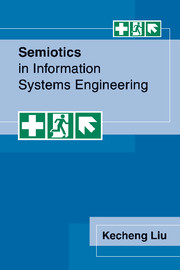Book contents
- Frontmatter
- Contents
- Preface
- 1 Introduction
- Part one Semiotic framework and methods
- Part two Applications
- 9 From semiotic analysis to systems design
- 10 Semantic temporal databases
- 11 Normbase: a new approach to information management
- 12 Case study: development of a land resources information system
- 13 Case study: development of a test construction system
- Appendix A Semantic templates and surrogate specification
- Appendix B LEGOL applications in the CRIS case
- Bibliography
- Index
13 - Case study: development of a test construction system
Published online by Cambridge University Press: 19 September 2009
- Frontmatter
- Contents
- Preface
- 1 Introduction
- Part one Semiotic framework and methods
- Part two Applications
- 9 From semiotic analysis to systems design
- 10 Semantic temporal databases
- 11 Normbase: a new approach to information management
- 12 Case study: development of a land resources information system
- 13 Case study: development of a test construction system
- Appendix A Semantic templates and surrogate specification
- Appendix B LEGOL applications in the CRIS case
- Bibliography
- Index
Summary
This case study demonstrates how semiotic methods can be used for systems analysis, and the other stages of systems development are covered by other approaches. The chapter also discusses why, after having tried other systems analysis methods, the Semantic Analysis method was chosen for the project.
Background
CONTEST (COMputerised TEST construction system) is a software engineering project which started from research and then evolved into a commercial project. In this project, Semantic Analysis has been applied for requirement analysis. An object-oriented system design has been produced based on the semantic model, and, further, the system construction has been carried out using object-oriented programming languages and tools.
The project commenced from two doctoral research projects, in which the major theoretical investigation and some experiments were conducted (Adema 1990, Boekkooi-Timminga 1989). A system analysis and design were performed which led to a prototype. The research project has been continued and expanded with input of more resources. The current objective of the project is to produce a practical, useful, computerised system for automatic management and production of tests.
CONTEST project
Tests are traditionally managed and produced manually. The questions (or the items as termed by the educational professionals) are written by the item composers, and centrally collected and stored with their attributes in an item bank in a test agency.
Information
- Type
- Chapter
- Information
- Semiotics in Information Systems Engineering , pp. 180 - 195Publisher: Cambridge University PressPrint publication year: 2000
